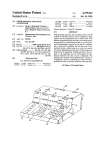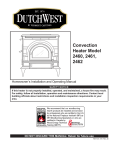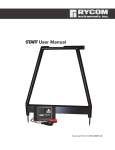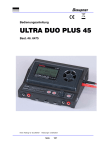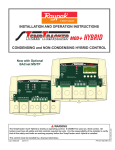Download SR-1 Rev2.1
Transcript
THINKING! AHEAD EPL ! SOLUTIONS INC. SR-1 Precision Camera / Sonde ! Cable & Pipe Locator ! User Manual 512Hz SR-1 Precision Introduction ! Congratulations on the purchase of your new SR-1 Precision Locator . The RS-1 Precision is specially designed to pinpoint sewer lines (inspection camera transmitters & sonde) and detect buried power cables, CATV cables, gas and water pipes, telephone cables, fiber optic cables with sheath.! ! The Transmitter is a multi-frequency active signal generator . The Receiver is a multi-frequency locator used to locate the relative position of inspection camera transmitters, sondes and buried utilities by active signal or passive signals.! DISCLAIMER OF LIABILITY! EPL SOLUTIONS, INC SHALL NOT BE LIABLE TO DISTRIBUTOR, RESELLER, OR ANY OTHER PERSON FOR ANY INCIDENTAL, INDIRECT, SPE- CIAL, EXEMPLARY OR CONSEQUENTIAL DAMAGES, OR INJURY OF ANY TYPE WHATSOEVER, AND CAUSED DIRECTLY OR INDIRECTLY BY PRODUCTS SOLD OR SUPPLIED BY EPL SOLUTIONS, INC ! !! !! !! !! !! !! !! !! !! !! !! !! !! Prepare for Use! Unpack your new SR-1 Precision Camera / Sonde, Cable and Pipe Locator . Make sure there is no shipping damage and all the parts are included.! ! Locate the battery compartment on the back of the Receiver and back of the Transmitter . Open the compartment using a phillips screwdriver . Install the “C” batteries as marked.! ! Locate the battery compartment on the back of the Transmitter . Remove the battery compartment door . Install the “C” batteries as marked. !! ! THINKING! AHEAD Page 1 EPL ! SOLUTIONS INC. (714) 453-9760 www.eplsolutions.net ! SR-1 Precision 512Hz Tip #1 Always keep the receiver as vertical as possible while performing a line location. Waving the receiver side to side will produce inaccurate locations. ON/OFF Button! Press the ON/OFF button to turn the Receiver on or off. Upon turning the unit on, it will load the settings from the previous usage.! Note: Unit will automatically shut off if no keys are pressed within a 10 minute period. ! ! DEPTH Button! Pressing the DEPTH button will cause the Receiver to first display the depth measured. To change the Depth Measurement from English to Metric, hold the Depth Key for ten seconds and the next setting will appear.! ! Steps /Mode Button ! Used to change Sonde Locate (STEP -1 and STEP-2) or Line Trace (Peak, Null. Pinpoint Peak)! ! Freq. Button (*)! Used to change locate frequencies. ! Sonde - 512Hz, 8KHz, 33KHz, 116KHz! Line - 512Hz, 8KHz, 33KHz, 65KHz, 116KHz, RF, 60Hz! (*)Press and hold for 5 sec. to turn on back lighting on/off! ! Gain Buttons! Adjusts the gain up or down . If the signal strength shows as “ --- ” on the display, pressing the GAIN will automatically adjust to 85% on the scale display . !! ! THINKING! AHEAD Page 2 EPL ! SOLUTIONS INC. (714) 453-9760 www.eplsolutions.net SR-1 Precision How to pinpoint a camera sonde in three easy steps with the SR-1 Precision Step 1 peak -null- peak signal Locate the sondes equator PIPE Locate the sondes poles peak -null- peak signal Step 2 PIPE Equator and Poles located X marks the spot PIPE Step 3 Surface Place SR-1 on the X. Push button depth PIPE !! ! THINKING! AHEAD Page 3 EPL ! SOLUTIONS INC. (714) 453-9760 www.eplsolutions.net SR-1 Precision Step 1 (S-1) Press the Steps button so S-1 is displayed below the graph bar. ! 1. ! ! ! ! ! ! Walk along the suspected path of the pipe. When you’re within proximity of the sonde, your receiver will produce a tone that is known as a peak signal. When the receiver passes over the equator of the Sonde the tone will suddenly become void which is called a null. You’re looking for a peak -null- peak signal when you are passing the Equator of the sonde during step 1. 3. Place a marker on the surface where you just located your first null. 4. Walk in a circular motion no more than 6ft towards the other side of the suspected path of the pipe. The receiver will produce a peak -null- peak signal again when you pass over the other side of the sonde. 5. Place a marker on the surface where you just located your second null and have completed step 1. NOTES: The receiver can be at any rotation along during Step 1. The deeper or further away you are from the Sonde, the wider the peak -null- peak signal will be. Adjust signal strength up or down with the gain control as needed to narrow your peak -null- peak signal . This step is usually performed only for Step 1. Le f .C 6 ft Ri gh tS id pe e ak -n ul lpe a k ircl e Tip #2 A peak -null- peak signal will be found along the equator line from marker to marker. tS id e of E qu at or of E qu si at gn or al Figure 1 Figure 2 !! ! THINKING! AHEAD Page 4 EPL ! SOLUTIONS INC. (714) 453-9760 www.eplsolutions.net SR-1 Precision Step 1 (S-1) Pipe When you can not get on both sides of the Equator? ! The Equator is a invisible straight line. Markings can be placed anywhere along one side of the Equator to show this invisible straight line. Area Not Accessible 6 ft. Circle peak -null- peak signal Pipe Area Not Accessible Figure 3 !! ! THINKING! AHEAD Page 5 EPL ! SOLUTIONS INC. (714) 453-9760 www.eplsolutions.net SR-1 Precision Step 1 (S-1) When diving down on a 45º the Equator? ! Locating the Equator is no different than if the Sonde was laying flat. It is however necessary to go back and adjust your location for pinpoint accuracy. ! ! This adjustment is performed only after completing all the steps. In Step 2 you will discover the Sonde is not laying flat.! ! After completing all the steps, calculate the depth into inches and divide by 2 as shown in Example 1. ! ! Location After! Location Before! 4’-2” deep 25” Surface 4’ -2 ”= 50 ” Example 1! 4’-2” = 50”! 50” / 2 = 25” Figure 4 !! ! THINKING! AHEAD Page 6 EPL ! SOLUTIONS INC. (714) 453-9760 www.eplsolutions.net SR-1 Precision Step 2 (S-2) S-2 Press the Steps button so S-2 is displayed below the graph bar. ! When the receiver is directly in front of or behind the Sonde the tone will suddenly become void which is called a null. You’re looking for a peak -null- peak signal when you are directly in front of or behind the Sonde during step 2. ! 1. ! ! ! !! Step 2ft. - 3ft. towards the front the sonde to locate the peak -null- peak signal as shown in figure 2. A. (For accurate peak -null- peak signal location in step 2 it’s best to have the receiver parallel to the right and left side markers as shown in figure 2.) 2. Place a marker on the surface where you located front null. 4. With the receiver 2ft - 3ft. towards the back side of the sonde, look for a peak -null- peak signal again on the back side of the sonde as shown in figure 2. 5. Place a marker on the surface where you located back null. NOTES: The deeper or further away you are from the Sonde, the wider the peak -null- peak signal will be. Adjust signal strength up or down with the gain control as needed to narrow your peak -null- peak signal . ! a pe k ea -p l l -nu al ign s k 2ft. - 3f t. Back Pole tor ua q E 2ft. - 3f t. Front Pole tor ua q E a pe k ea -p l l -nu al ign s k Figure 5 !! ! THINKING! AHEAD Page 7 EPL ! SOLUTIONS INC. (714) 453-9760 www.eplsolutions.net SR-1 Precision Step 2 (S-2) S-2 When you can not get on both sides Poles? ! The poles are a invisible straight line. Markings can be placed anywhere in front side or the back side of the Sonde to show this invisible straight line. peak -null- peak signal Area Not Accessible Figure 6 Pipe Area Not Accessible !! ! THINKING! AHEAD Page 8 EPL ! SOLUTIONS INC. (714) 453-9760 www.eplsolutions.net SR-1 Precision Step 2 (S-2) When diving down on a 45º ? ! The Front Pole as shown will be a weaker and wider Peak-Null-Peak signal than the Back Pole. Front Pole Back Pole Surface Figure 7 !!! EPL ! SOLUTIONS INC. Page 9 (714) 453-9760 www.eplsolutio SR-1 Precision Step 3 Depth ! With the receiver over Step 3 as shown in figure 3 push the depth measurement button for the invert depth (bottom inside) of the sewer pipe. NOTE: For best depth measurement results, keep the receiver at a right angle to the step 1 side markers as shown in figure 3. tor ua q E Back Pole Step 3 Front Pole r ato u Eq Figure 8 !! ! THINKING! AHEAD Page 10 EPL ! SOLUTIONS INC. (714) 453-9760 www.eplsolutions.net SR-1 Precision Pipe When you can not get over sonde on? ! Locate your Equator and Poles around all sides of the Sonde as shown if possible. If all sides are not accessible move sonde backwards or forwards a few feet to confirm location accuracy. Area Not Accessible 6 ft. C Figure 9 Area Not Accessible Pipe peak -null- peak signal ircle !! ! THINKING! AHEAD Page 11 EPL ! SOLUTIONS INC. (714) 453-9760 www.eplsolutions.net SR-1 Precision Circle peak null- p eak peak -null- peak signal How to locate a vertical sonde.! 1. Select Step-2. ! 2. Walking in a circle and facing towards the center of the circle locate the 4 peak-nullpeak signals as shown. ! 3. Confirm the accuracy of the locate by locating the 5th peak-null-peak signal in the center as shown k pea signal pea l l -nu al ign s k Surface Pipe Figure 10 !! ! THINKING! AHEAD EPL ! SOLUTIONS INC. (714) 453-9760 www.eplsolutions.net SR-1 Precision Depth Measurement By Calculation ! (Horizontal Location Only!) (Depth Nulls are not to be confused with Front and Back Poles)! Once the sonde has been located the depth can be checked for accuracy. ! 1. Select Step-2. ! 2. Moving the SR-1 towards the Front Pole keeping the SR-1 inline (as shown) locate and mark a peak-null-peak signal (Depth Null A)! 3. Moving the SR-1 towards the Back Pole keeping the SR-1 inline (as shown) locate and mark a peal-null-peak signal (Depth Null B)! 4. Measure the distance in inches between Depth Null A & B and multiply by .7! ! Example: Distance between Depth Nulls A & B is 100” X .7 = 70” deep (surface to center of sonde) peak -null- peak signal peak -null- peak signal 100” Surface Front Pole Back Pole 70” ! Peak Ghost Peak Ghost Peak Pipe Depth Null! A Depth Null! B !! ! THINKING! AHEAD Figure 11 EPL ! SOLUTIONS INC. (714) 453-9760 www.eplsolutions.net SR-1 Precision How to locate a Deep (15- 25 feet plus) sewer or drain line with the SR-1 Precision Step 2 peak signal Locate the sondes equator peak signal Step 1 Locate the sondes poles Step 3 Push button depth !! ! THINKING! AHEAD EPL ! SOLUTIONS INC. (714) 453-9760 www.eplsolutions.net SR-1 Precision How to locate a Deep (15- 25 feet plus) sewer or drain line with the SR-1 Precision Press the Steps button so S-2 is displayed below the graph bar. ! 1. Step (S-2) Walk along the suspected path of the pipe holding the receiver in line with the general direction of the path of the pipe. When you’re within proximity of the sonde, your receiver will produce a tone that is known as a peak signal. When the receiver passes over the equator of the Sonde a tone will found which is called a peak signal. ! ! ! ! ! ! You’re looking for a peak signal when you are passing the Equator of the sonde during this step. 3. Place a marker on the surface where you just located your first peak. 4. Walk in a circular motion no more than 6ft towards the other side of the suspected path of the pipe. The receiver will produce a peak -null- peak signal again when you pass over the other side of the sonde. 5. Place a marker on the surface where you just located your second null and have completed step 1. NOTES: The receiver can be at any rotation along during Step 1. The deeper or further away you are from the Sonde, the wider the peak -null- peak signal will be. Adjust signal strength up or down with the gain control as needed to narrow your peak -null- peak signal . This step is usually performed only for Step 1. nal sig ve k o Le ea t p tly ab ft s e Si ng direc o de r Tip St hen A peak signal will be found w of along the equator line when Eq the SR-1 is in-line with the ua to sonde. r Ri gh tS id e pe ak si gn al of E qu at or Figure 1 1. Move slowly when locating deep. 2. Pay attention to the signal strength. 3. The signal will be strongest directly above the sonde. !! ! THINKING! AHEAD EPL ! SOLUTIONS INC. (714) 453-9760 www.eplsolutions.net SR-1 Precision Step 1 (S-2) S-1 1. Move slowly when locating deep. 2. Pay attention to the signal strength. 3. The signal will be strongest directly above the sonde. A peak signal will be found when you are above and in-line with the sonde with the SR-1 as shown. A null signal will be found above when the SR-1 is not in-line (at a right angle) with the sonde as shown. This step verifies that you are above the sonde. !! ! THINKING! AHEAD EPL ! SOLUTIONS INC. (714) 453-9760 www.eplsolutions.net SR-1 Precision How to locate a Deep (15- 25 feet plus) sewer or drain line with the SR-1 Precision S-1 Step 1 (S-1) Press the Steps button so S-1 is displayed below the graph bar. ! When the receiver is directly in front of or behind the Sonde the tone will be a peak signal only when you are directly in front of or behind the Sonde during step 1. ! 1. ! ! ! !! Step 3ft. - 4ft. towards the front the sonde to locate the peak signal as shown in figure 2. (For accurate peak signal location in step 1 it’s best to have the receiver parallel to the right and left side markers as shown in figure 2.) 2. Place a marker on the surface where you located front null. 4. With the receiver 2ft - 3ft. towards the back side of the sonde, look for a peak -null- peak signal again on the back side of the sonde as shown in figure 2. 5. Place a marker on the surface where you located back null. NOTES: The deeper or further away you are from the Sonde, the wider the peak -null- peak signal will be. Adjust signal strength up or down with the gain control as needed to narrow your peak -null- peak signal . ! al ign s ak pe 3ft. - 4f t. Back Pole tor ua q E Front Pole al ign s ak pe tor ua q E Figure 5 !! ! THINKING! AHEAD EPL ! SOLUTIONS INC. (714) 453-9760 www.eplsolutions.net SR-1 TX Transmitter Controls and Indicators SR-1 TX TX OUTPUT JACK! The Red/Black cord, Inductive Coupler connects here to create a direct connect or coupler inductive circuit on the buried utility.! ! TX ON! Frequency and other LCD segments visible indicates unit is on .! FREQUENCY SELECTOR! Selects frequencies by toggle through available frequencies . 512Hz, 8kHz, 33kHz, 65kHz, 116KkHz are standard on the SR-1 Tx .! LOAD RATE INDICATOR! The Load Rate Indicator symbol flashes to indicate signal transmission via coupler induction or direct connection .! OUTPUT SIGNAL LEVEL CONTROL! The OUTPUT SIGNAL LEVEL CONTROL adjusts the power output from the Transmitter .! RELATIVE RESISTANCE, VOLTAGE AND CURRENT METER! The transmitter can display the resistance, voltage and amperage of the transmitted frequency . NOTE: This is a relative measurement based on the feedback from the transmitted signal . !! ! THINKING! AHEAD EPL ! SOLUTIONS INC. (714) 453-9760 www.eplsolutions.net Plug the red/Black TesT cord into the TX OUTPUT JACK. Selec Connect the red TesT cord to an existing ground point or an exposed metallic section Power Output Indicator, Load Rate Indicator and the Frequen of the utility . Place the Ground rod approximately 10 feet from this point, at an angle Direct Connection of 90º to the buried cable or pipe. Push the Ground rod into the ground 8 to 10 Transmitter inches. Connect the Black TesTCAUTION cord to the Ground rod. CAUTION DFF F.1 F.2 kHz mA v kM SR-1 TX ! DO NOT CONNECT TO LIVE OR ALWAYS TURN OFF TRANSMITTER BEFORE CONNECTING AND DISCONNECTING TEST LEADS ENERGIZED POWER CABLES Plug the red/Black TesT cord into the TX OUTPUT JACK. Select the FREQUENCY. The cord connects to utility Direct Connection is the most reliable method of signal application. Thisdisplayed. method isRed relPower Output Indicator, Load Rate Indicator and the Frequency will be (unbond this end for best results) atively free of interference. The greatest amount of signal strength can be achieved by this method. All frequencies may be used. The far end of the utility must be grounded. Transmitter DFF F.1 F.2 kHz mA v kM Connect the red TesT cord to an existing ground point or an exposed metallic section of the utility . Place the Ground rod approximately 10 feet from this point, at an angle of 90º to the buried cable or pipe. Push the Ground rod into the ground 8 to 10 inches.Buried Utility to Locate Connect the Black TesT cord to the Ground rod. Far end o buried utili must be bon Black cord connects Red cord connects to utility Plug the red/Black TesT c ord into the TX OUTPUT JACK. Select the FREQUENCY. to transmitter ground rod The (unbond this end for best results) Power Output Indicator, Load Rate Indicator and the Frequency will be displayed. Flexicoupler Connection Transmitter DFF F.1 F.2 kHz mA v kM The optional Flexicoupler and Hard coupler are very easy to u Buried Utility have to be interrupted. The operation range is shorter than for to Locate ods. The tracing signal can be affected by neighboring cables Direct Connection Far end of Black cord connects to transmitter groundTrod buried utility esT cord or the Ground rod are not needed for this method. must be bonded Successful coupler operation requires an insulated Direct Connection is the most reliable method of signal application. The greatest amount of signal strength can be conductor t Flexicoupler Connection near andthe far far ends. achieved by this method. All frequencies may be used. For best results end of the utility should be grounded .! The optional Flexicoupler andConnection Hard coupler are Fvery easy to use, and services do not Flexicoupler Loop the lexicoupler around the cable and connect the two have to be interrupted. The operation range is shorter for Direct Connection methFlexicoupler and Haround ard couplerthan are easy to use, services do not coupler the cable. isandimportant torod connect the co Connect the red cord to an existing ground pointThe or optional an exposed metallic section of very the utility .ItPlace the Ground have toaffected be interrupted. The operation range iscables shorter than for Direct Connection methods. The tracing signal can be by neighboring and pipes. The r ed/Black needing to be traced. Connect the coupler around approximately 10 feet from this point, at an angleods. of The 90o to the buried cable or pipe . Push the Ground rod into the ground the wire tracing signal can be affected by neighboring cables and pipes. The red/Black TesT cthe ord or the Ground rod are not needed fornotthis method. TesT c ord or therod G round needed for this method. ground. The result will be a strong cable not near the system 8 to 10 inches . Connect Black Test cord to the Ground .! rod are Successful coupler an operation requires an insulated conductor is grounded on on bothboth Successful coupler operation requires insulated conductor that that is grounded near and far ends.near the grounding, the range will also be shorter, and difficul near and far ends. Loop the Flexicoupler around the cable andanother. connect the Power two ends,Output or clamp Indicator, the Hard one cable from Plug the red/Black Test cord into the TX OUTPUT JACK . Select the FREQUENCY . The Load coupler around the cable. Itconnect is important the to connect the coupler around the cable Loop the Flexicoupler around the cable and two ends, or clamp the Hard Plug the c oupler T esT c ord into the TX OUTPUT JACK. Always se Rate Indicator and the Frequency will be displayed. needing to be traced. Connect the coupler around the wire closer to the outgoing coupler around the cable. It not is important connect the around the cable cable near the system to ground. The result will be coupler a stronger signal. By connecting ignated by the coupler. The most common is the 82 kHz FREQ near the grounding, the range will also be shorter, and difficulty may arise determining needing to be traced. Connect the available coupler around the wire closer to the outgoing in multiple frequencies. one cable from another. cable not near the system ground. result willTX be a JACK. stronger connecting Plug the couplerThe TesT cord into the OUTPUT Always signal. select the By frequency designated by the coupler. The most common is the 82 kHz FREQUENCY, but coupler are Transmitter near the grounding, the range will also be shorter, and difficulty may arise determining available in multiple frequencies. one cable from another. Plug the coupler TesT cord into the TX OUTPUT JACK. Always select the frequency designated by the coupler. The most common is the 82 kHz FREQUENCY, but coupler are Inductive Coupler available in multiple frequencies. Wraps Utility Red cord connects to utility (unbond this end for best results) Buried Utility to Locate Far end of buried utility must be bonded Black cord connects to transmitter ground rod DFF F.1 F.2 kHz mA v kM Transmitter DFF F.1 F.2 kHz mA v kM Inductive Coupler Wraps Utility Transmitter Direct Connection CAUTION CAUTION DFF F.1 F.2 kHz Buried Utility to Locate mA v kM Near End of Buried Utility Must Be Bonded Far End of Buried Utility Must Be Bonded DO NOT CONNECT TO LIVE OR Inductive Coupler Connection InductiveACTIVE NEVER BOND ENERGIZED POWERCoupler CABLES POWER CABLES Wraps Utility ! CAUTION Buried Utility to Locate Near End of TURN OFF TRANSMITTER Far End of ALWAYS BEFORE Buried Utility Buried Utility CONNECTING AND DISCONNECTING TEST LEADS Must Be Bonded Must Be Bonded Direct Connection is the most reliable method of signal application. This method is relatively free of interference. The greatest amount of signal strength can be achieved by 800.851.7347 www.rycominstruments.com into the TX OUTPUT JACK . The Inductive Coupler performs at 8kHz, 33kHz, 65kHz this method. All frequencies may be used. The far end of the utility must be grounded. Plug the Inductive Coupler cord 116kHz frequencies. The most commonly used is 65kHz.Buried ! Utility & 4 Connect the red TesT cord to an existing ground point or an exposed metallic section to Locate this point, at an angle ground 8 to 10 inches. and services do not have to be interrupted . The operation range of the utility . Place the Ground rod approximately 10 feet from Near End of Far End of of 90º to the buriedBuried cable or pipe. Push the Ground rod into the Buried Utility Utility Connect the BlackMust TesTBec ord to the Ground rod. Must Be Bonded Bonded The optional Inductive Coupler is very easy to use, is 800.851.7347 shorter than for Direct Connection methods and the tracingwww.rycominstruments.com signal can be affected by neighboring cables and pipes. ! Plug the red/Black TesT cord into the TX OUTPUT JACK. Select the FREQUENCY. The Power Output Indicator, Load Rate Indicator and the Frequency will be displayed. It is best to use the Inductive Coupler around a group of LIVE CABLES needing to be traced, the result will be a stronger signal . Connecting the Inductive Coupler around PIPE AND CONDUIT, DISCONNECTED OR INACTIVE CABLES, will produce poor results and difficulty will arise. ! Transmitter DFF F.1 F.2 kHz mA v kM 800.851.7347 www.rycominstruments.com Red cord connects to utility (unbond this end for best results) Note:! When a ground wire is present it is always best use the Direct Connection Method only after the ground wire has 4 been checked for an absence of power with a voltage meter. Buried Utility to Locate Flexicoupler Connection Black cord connects to transmitter ground rod Far end of buried utility must be bonded The optional Flexicoupler and Hard coupler are very easy to use, and services do not have to be interrupted. The operation range is shorter than for Direct Connection methods. The tracing signal can be affected by neighboring cables and pipes. The red/Black TesT cord or the Ground rod are not needed for this method. THINKING! Successful coupler operation requires an insulated conductor that is grounded on both AHEAD near and far ends. Loop the Flexicoupler around the cable and connect the two ends, or clamp the Hard coupler around the cable. It is important to connect the coupler around the cable needing to be traced. Connect the coupler around the wire closer to the outgoing (714) 453-9760 www.eplsolutions.net cable not near the system ground. The result will be a stronger signal. By connecting near the grounding, the range will also be shorter, and difficulty may arise determining one cable from another. Plug the coupler TesT cord into the TX OUTPUT JACK. Always select the frequency designated by the coupler. The most common is the 82 kHz FREQUENCY, but coupler are !! ! EPL ! SOLUTIONS INC. SR-1 TX Selecting A Trace Signal Frequency The choice of 512Hz, 8kHz, 33kHz, 65 kHz and 116kHz Frequency is dependent on the conditions of the locate .! The 512 Hz, 8 kHz, 33kHz, 65kHz and 116 kHz signals each have their advantages . It is recommended to begin by using the 8 kHz signal, and continue as long as you are confident in the results . If the signal is very weak try to adjust the connection or grounding . If there is no improvement in signal then try 33kHz. Repeat adjustments of ground and connection point again until switching to 116kHz. The 512Hz signal 8 kHz and 33kHz takes the best of both high and low frequency.! ! 512Hz (lower frequency) ! • Signal is usually preferred for a loop trace. ! • Has a long locating range. ! • Not very susceptible to bleed off or coupling! • Less likely to jump impedance on the utility than mid-range and high-range frequencies.! • Susceptible to locating errors caused by nearby high voltage electrical cables (50Hz- 60Hz). ! • Will not travel well through disconnected shield bonds or insulated pipe bushing .! ! 8 kHz (mid-range frequency) 33kHz (high frequency)! • Less susceptible to locating errors caused by nearby high voltage electrical cables (50Hz- 60Hz).! • Has a better locating range than higher frequencies.! • Not very susceptible to bleed off or coupling! • Less likely to jump impedance on the utility than high-range frequencies.! • Mid range frequency is not very susceptible to bleed off or coupling but can jump impedance on the utility better than the 512 Hz! • 8 kHz is one of the most common frequencies used to locate coaxial cable and telecom pairs .! ! 65kHz and 116kHz (high frequency) ! • Less susceptible to locating errors caused by high voltage electrical cables (50Hz- 60Hz) .! • Locating range is shorter than the 512Hz, 8kHz and 33kHz signal . ! • 65 kHz (higher frequency) is sometimes better than the 8kHz (mid-range frequency) and 33kHz (high frequency) for locating sharp corners in cables or pipes.! • 65kHz and 116kHz signal is also better for “jumping” disconnected shield bonds or grounds, or tracing signal may indicate one of these characteristics. ! • The locating range is quite short for the 116kHz signal so the Transmitter must be repositioned more often during the tracing operation. ! • High Frequencies are useful for applying a signal using the Inductive Coupler. !! ! THINKING! AHEAD EPL ! SOLUTIONS INC. (714) 453-9760 www.eplsolutions.net ti u r a r l e u t s t in ood in o n are e g v s a e h lose t s rvic c u e SR-1 TX s s a e m ort. nd ide p i a s THE p , s F h T r i e s s O o n u be le o l n IDE l r o t b i e e S T a t w h T i t c n e m e , h e l s ul nt The g rang en i N ran o T . r e d S T the e T Inductive Coupler Connection e i n W i c y d t m a s O l b e a . P ne per ARR ad Tran arried n o o t e t e h u h ro l c nt b a g i n l Hzandbservices e , or t This method is convenient2 tokuse, g A h i s interrupted test cordseor connections are needed . The cable 8 torethet. No h ipe. are lnot a e t c h or pipe must have good insulationr orp non-conductive coating, operating range will be short .! r t o 90 g fo ress cable o e. First, n e i P k h . t o N o 65kHz & 116kHz frequencies. The most commonly n is na the SR-1 are l33kHz, iused h e r O Turn theTX ONle. TheoInductive l r pip frequencies i c f r h 65kHz. ! o sig a w e e S h . t r path the cab le path e If or pipe.! signa T .cable h smatiTa 15º angle Place SR-1 TX on its side . Align the ARROWS on the SIDE OF THE TRANSMITTER totthe b n a h a a t i p c ng Tr e o r d e h t t e s h ne w Startetracing t t t as shown c the path with the receiver 25 feet from the SR-1 TX 45º of either side of the m. Search infthe lasutility low l p o r x o e f e h t t TX to a point 25 feet Locate the cable or pipe, and follow the path becomes move d he below. fee. If.! the signal and weak,eh n the SR-1 i , 5 behind the last strong signal, and continue searching 2 e r tb pip e eive r e c o f e r ble oint 25 e h a t c p with te the a h o t t a ack a tter P y i m he p ve. Loc ransmiTTer s an lit On Tr o the Uti o T s b w o T e Arr llel n a e th Align and Para v o e Abov ak, m hing. arc e s e y Utilit Direc ARR PLACE LE PATH NG CAB E MOD OW ALO UCTIVE FOR IND TX SR-1mitter 25’ 15º tion Utility! Direction s Tran 45º side r Out itter e v i e sm Rec With m the Tran tility y t i l i Fro e Ut of U Locat ot Radius ither Side 5 Fo of E of a 2 ithin 45º and W if e r a t aw d th o n or is iTTer an t a r spe pe nsm o e a r e m T sa if th e. The e h d t o re e i t s u d u a q u i s s es i s techn or walk es an a u q i t EPL r! giv THINKING! thi raAHEAD c hn ! r e e o t p f ive o ! eceSOLUTIONS r. g d n TeINC. i h e T t i c d a m r a s e ! loc nee ther. E h ran t T h e r n c e r 453-9760 www.eplsolutions.net th ea le a ach o er. Whe a(714) S d p n o d n e e li r p m oth o eive o r h c w f e T c ea ists. way he r SR-1 Precision How to locate cable or pipe using the SR-1 Precision Locating Cable Locating or Pipe the Cable or Pipe Locating the Cable or Pipe Make sure the TransmiTTer is connected and in the ON position. Then move approximately 15 feet (4. Make sure Make the SR-1 TXthe signal generator is connected andininthe theON ONthe position Thenmove move approximately .5 the Inductive sure TransmiTTer is connected and position. approximately 15 feet feet(4(4.5 meters) away from the TransmiTTer along path..Then (Move about 25 feet (7.5 15 meters) for meters) away for conductive search mode from the SR-1 TX signal generator along the path . (Move about 25 feet (7 .5 meters) awaysearch from the T ransmiTTer along the path. (Move about 25 feet (7.5 meters) for the Inductive mode.) meters) forsearch the Inductive search mode.)! mode.) Hold the receiver so that you can see the LCD bargraph and controls easily. Make sure the receiver and HoldPrecision the receiver that can LCD bargraph controls easily. Make sure sure the Hz rthe eceiver and Hold the SR-1 Receiver soyou that you see can the seeare theboth LCD bar-graph controls easily . either Make Receiver the so TransmiTTer FREQUENCY set for and the and same FREQUENCY, 815 (lower), 8 kHz, 33kHz o the T ransmiTTer FREQUENCY are both set for the same FREQUENCY, either 815 Hz (lower), 8 kHz, 33kHz or and the Transmitter FREQUENCY are both for the FREQUENCY, either 512 Hz 8 kHz, 82 kHz (higher). Orset select thesame passive locating mode which do(lower), not require the(mid-range) transmitter 82 kHz (higher). Or select the locating mode which do not transmitter 33kHz, 65kHz or 116kHz (high-range) . Orpassive select the passive locating modes, RFrequire or 60Hzthe which do not require a Selecting the Locating Mode (Peak or Null) transmitter.! Selecting the Locating Mode (Peak or Null) Press the MODE button to select the desired Peak or Null locating method. Selecting the Locating Mode (Peak, Sharp the Peak or Null, Target Null)! Press the MODE button to select desired Peak or Null locating method. Press the MODE button to select the desired Peak or Null locating method . Peak Mode Receiver Max Null Mode Receiver Min Peak Mode Receiver Max over cable Null Mode Receiver Min over cable Signal Signal Signal over cable Signal over cable Buried cable Buried cable (End view) (End view) Buried cable Buried cable (End view) (End view) Peak Locating Mode Peak Mode Locating Peak Mode Locating Keep the receiver in a vertical position . Move the receiver left to right across the path . When the receiver is directly Keep the receiver in a vertical position. Move the receiver left to right across the path. When the receiver above the cable pipe, rotate receiver for a maximum signal . As left you move receiver away When from the path, Keep or the receiver in the a vertical Move the rrotate eceiver rightthe across the path. thecable receiver is directly aboveposition. the cable or pipe, the rto eceiver for a maximum signal. As you move the receiver the meter reading (and audio frequency response) will drop off .! is directly above thefrom cable pipe, path, rotatethe themeter receiver for a maximum signal. As youresponse) move thewill receiver away theorcable reading (and audio frequency drop off. away from the cable path, the meter reading (and audio frequency response) will drop off. If you rotate the receiver Ifwhile the the cable, a sharp NULL will the identify the cable’s when aligned the flat youover rotate receiver while over cable, a sharpdirection NULL will identify thewith cable’s direction. It is you rotate aligned the receiver while over the cable, a sharp NULL will identify the cable’s direction. It is side of the Ifreceiver. with the flat side of the receiver. aligned with the flat side of the receiver. Tip #1 Always keep the receiver as vertical as possible while performing a line location. Waving the receiver side to side will produce inaccurate MAXIMUM locations. RECEIVER SIGNAL CABLE PATH MAXIMUM RECEIVER SIGNAL CABLE PATH CABLE PATH CABLE PATH NULL SHOWS NULL SHOWS CABLE CABLE DIRECTION DIRECTION !! ! THINKING! AHEAD EPL ! SOLUTIONS INC. (714) 453-9760 www.eplsolutions.net SR-1 Precision Peak Locating Mode continued Trace the path by walking away from the transmitter at a moderate pace. Move the receiver to the left and right while walking, following the PEAK signal .! ! As you trace the path, the PEAK meter reading may slowly fade as you move away from the transmitter. Press and release the GAIN buttons as needed to compensate for changes in level (higher or lower). One of the following may occur:! • a junction where the signal divides and goes several directions. ! • a break in the cable or shield.! • a change in the depth of the cable or pipe. d) an insulated pipe fitting.! • a slack loop of cable.! If you can no longer trace the path, even with the GAIN set to maximum, connect the transmitter to the far end.of the path and trace back to the point where you lost the signal.! ! Mark the straight sections of the path every few feet. Mark sharp curves, loops, and cable bundles every foot or so. Sharp changes in the path cause the receiver PEAK and NULL indications to behave differently than when tracing a straight path. Practice on the path that you know has turns and laterals in it. This will help you to recognize the conditions within the field. Null Locating Mode Move the receiver left to right across the cable path. When the receiver is directly above the cable or pipe, a NULL (lowest meter reading and lowest audio tone) will occur. When moving the receiver to left or right of the NULL point, the meter reading will rise to a maximum point (PEAK). The audio tone will also be at its. highest pitch. When the receiver is moved beyond the PEAK, the meter reading will begin to fade.! Trace the path by walking away from the transmitter at a moderate pace Move the receiver to the left and right when walking, following the NULL indications.! As you trace the path, the PEAK meter reading may slowly fade as you move away from the transmitter. Press and release the GAIN buttons as needed to compensate for changes in signal level. If the PEAK meter readings suddenly changes in level (higher or lower), one of the following may have occurred:! • a junction where the signal divides and goes several directions. ! • a break in the cable or shield.! • a change in the depth of the cable or pipe. ! • an insulated pipe fitting.! • a slack loop of cable.! ! If you can no longer trace the path, even with the GAIN control set to maximum, connect. the transmitter to the far end of the path, and begin tracing the path back.! Mark the straight section of the path every few feet. Mark sharp curves, loops, and cable bundles every few inches. Sharp changes in the path causes the receiver PEAK and NULL. indicators to behave differently than when tracing a straight path. Practice on the path that. you know has turns and laterals in it.This will help in recognizing the conditions within the field . !! ! THINKING! AHEAD EPL ! SOLUTIONS INC. (714) 453-9760 www.eplsolutions.net SR-1 Precision Absolute Signal Strength The SR-1 Precision Receiver provides the operator with a direct measurement of the receiver’s signal strength. The measurement is displayed with three numerical digits (ex:485) located at the top of the LCD display. The measurement range is from 0 to 999 indicating a very week signal (0) to a very strong signal (999). Absolute Signal Strength is independent of the GAIN setting. or meter reading. It gives the operator information about the actual amount of signal being radiated from the conductor and received by the receiver .! Measuring Absolute Signal Strength at any time is done by reading the number at the top. of the LCD display. The Absolute Signal Strength will not be displayed if the meter reading is. too high or too low. Adjust the GAIN to move the meter reading to mid-scale.The numerical display will change from ‘---’ to a valid measurement.! Absolute Signal Strength measurements are more sensitive to signal changes than the meter display PEAKS and NULLS can be more precisely pin-pointed.This measurement can also be used to monitor signal loss as the conductor is being traced. Absolute Signal Strength The GAIN up and down buttons are used to increase and decrease the gain in small. amounts.If the meter reading is very low, pressing the GAIN up button will center the meter reading to midscale. Likewise, if the meter reading is very high, pressing the GAIN down button will center the meter reading to midscale. Passive 50Hz / 60Hz ~ Locating The SR-1 Precision Receiver is capable of locating power utility frequencies. This MODE is useful for locating underground primary and secondary power utilities. In certain circumstances, this MODE will also locate water pipes, sewer lines, cable television, and telephone.The reason is that common electrical grounds are sometimes found among these various utilities Select the 50/60~ (Hz) frequency on the receiver. Select 60Hz mode. The SR-1 will locate conductor using the Sharp PEAK mode.! This method is useful because of its speed and convenience. Start at a known reference point and keep in mind that other conductors in the area may produce this same locating signal.! The SR-1 TX transmitter is not required to locate in this mode. Passive Radio Frequency Locating The SR-1 Precision Receiver is capable of passively locating metallic utilities where radio frequencies have coupled to the utility. This mode is useful for sweeping a green area for utilities. In certain circumstances, this mode will locate water pipes, cable television, gas lines and telephone. This locating option does not always detect buried utilities even when radio frequencies are present.This.method is useful because of its speed and convenience. Start at a known reference point and keep in mind that other conductors in the area may produce this same locating signal .! The SR-1 TX transmitter is not required to locate in this mode. !! ! THINKING! AHEAD EPL ! SOLUTIONS INC. (714) 453-9760 www.eplsolutions.net SR-1 Precision Push Button Depth The only way to be sure of the depth of a utility is to exposes the utility. ! At any given time, the depth readout may be inaccurate.! ! ! The SR-1 Precision Receiver can measure depth with the push of a button. The depth is displayed at the top of the LCD display in feet and inches. Push button depth is useful in quickly determining the depth of the utility during path locating.! Begin this measurement by locating the path of the cable or pipe. Move to the location where you want to measure the depth. Stay at least 15 feet (4 .6 . meters) away from the SR-1 TX transmitter. Pin-point this location as accurately as possible (see Peak Mode Locating page, Null Mode Locating page and Absolute Signal Strength page). Place the receiver vertically over the conductor and rest the foot of the locator on the .ground. While holding the receiver vertical, press and release the DEPTH.button.The receiver will briefly indicate a measurement is being performed and then display the depth at the top of the LCD .display.! ! Caution must be exercised when using the push button depth feature, as tilted magnetic fields and adjacent conductors can significantly influence this measurement. The operator should periodically check for adjacent conductors and tilted magnetic fields when taking.push button depth readings. For information on identifying tilted magnetic fields, refer to Tilted Magnetic Field Identification and Depth Measurement 45º Method.! ! Note: ! The SR-1 Precision Receiver is designed to alert the operator of potential current and depth measurement errors . If the display reads ‘Err’ during a current and depth measurement, the receiver has.detected a condition that could produce inaccurate readings.! ! ! Errors can exist when the conductor signal flow is too small. Check SR-1 TX transmitter hookup and far end access point for poor connections. This.cause of error can be identified by a high.GAIN setting (80 or greater on the bar-graph display).! The receiver may also be detecting adjacent cables or is not directly over the target conductor. Verifying target conductor path precisely before measuring current again.! If at anytime the display reads ‘CAL’, .contact EPL Solutions, Inc at (714) 453-9760. Current Measurement The SR-1 Precision Receiver later models contain a feature that is very useful in identifying a desired cable in a field of various conductors and/or utilities. ! It is not unusual for the target conductor (the conductor connected to the SR-1 TX transmitter) to induce a signal into nearby conductors in a crowded field. In these instances, the radiated signal on the conductors close to the surface of the earth, may be stronger than the transmitter signal on the target conductor buried deep in the ground. ! The operator will find two or more paths and must determine which is the target conductor. By using the current measurement feature of the SR-1 Precision Receiver, the operator can determine the amount of 512 Hz, 8kHz, 33kHz 65kHz or 116kHz current flowing on the conductors, regardless of the depth. ! The highest current flow indicates the target conductor. !! ! THINKING! AHEAD EPL ! SOLUTIONS INC. (714) 453-9760 www.eplsolutions.net and Within 45º of Either Side of Utility SR-1 Precision Blind Search d Search locating techniques is used if the operator is not aware . TwoThepeople aretechniques needed foroperator thisis not technique. ransmiTTer and Blind Search locating is used if the aware if a buried utilityThe exists . T Two people are for this technique . Using 65kHz keep the Transmitter and the Receiver 25 feet away from each other . Each feet needed away from each other. Each operator walks at the same sp operator walks at the same speed keeping a distance of 25 feet from each other . When the receiver gives an audio response, then a buried utility is present between the Receiver and the Transmitter. e of 25 feet from each other. When the receiver gives an audio re utility is present between the receiver and the TransmiTTer. Inductive Connection This method is convenient to use, and services are not interrupted. No test cords or connections are needed. The cable or pipe must have good insulation or nonconductive coating, or the operating range will be short. Turn the TransmiTTer ON. Press the 82 kHz button. Place TransmiTTer on iTs side as close as possible to the path of the cable or pipe. Align the ARROWS on the SIDE OF THE TRANSMITTER in line with the cable or pipe. First, locate the broad TransmiTTer Null, then move toward the expected cable path while looking for the signal carried by the cable. 65kHz Start tracing the path with the receiver 25 feet from the TransmiTTer. Search in the 90º zone as shown above. Locate the cable or pipe, and follow the path. If the signal becomes weak, move the TransmiTTer to a point 25 feet behind the last strong signal, and continue searching. 65kHz TRANSMITTER Align Arrows On Transmitter Pack Above and Parallel To the Utility 25’ PLACE ARROW ALONG CABLE PATH FOR INDUCTIVE MODE 45º DFF F.1 F.2 8869 Utility Direction Transmitter kHz mA v kM Locate Utility With Receiver Outside of a 25 Foot Radius From the Transmitter and Within 45º of Either Side of Utility Blind Search The Blind Search locating techniques is used if the operator is not aware if a buried utility exists. Two people are needed for this technique. The TransmiTTer and the receiver are Held 25 feet away from each other. Each operator walks at the same speed keeping a distance of 25 feet from each other. When the receiver gives an audio response, then a buried utility is present between the receiver and the TransmiTTer. TRANSMITTER DFF F.1 F.2 8869 kHz mA v kM 25 Feet (7.5 Meters) Between Transmitter and Reciever 25 Feet (7.5 Meters) Between Transmitter and Reciever RECEIVER 800.851.7347 www.rycominstruments.com 5 RECEIVER !! ! THINKING! AHEAD EPL ! SOLUTIONS INC. (714) 453-9760 www.eplsolutions.net SR-1 Precision Tilted Magnetic Field Identification When adjacent cables or pipes are present, they will sometimes create locating errors. Some of the SR-1 TX transmitter signal is picked up by the adjacent conductors and is redirected so that it combines with the original signal. The result is a Tilted Magnetic Field.This is often the reason that numeric depth readouts.are sometimes created in error.! The operator can verify the accuracy of path locate by performing the 45º Angle Method locate and the Depth Measurement Calculation. If readings agree to within 5 inches, the path locate is accurate. ! If the two depth readings do not agree, then dig with care A closer locate would be halfway between the two outside depth locate marks ! This is an important technique that should be used to ensure the most accurate location possible. Depth Measurement 45º Angle Method Move to the location you want to measure depth. Stay at least 15 feet away from the SR-1 TX transmitter. With the SR-1 Precision Receiver in Peak Mode sweep the receiver left to right across the path until the utility is located. Mark the path on the ground as precisely as possible using the Peak Locating Method.! The Depth measurement 45º Angle Method should be performed at different areas along the path of the utility and is effective for checking accuracy of location.! Place the receiver on the ground with.the LCD meter facing up. Position the unit so that the BUBBLE LEVEL (if equipped) on top of the meter is centered(45º). Pull the receiver away from the cable path (at 90º to the cable path) keeping the BUBBLE LEVEL (if equipped) centered. When the receiver indicate. a Peak-Null-Peak signal, mark the location of the receiver’s foot. The distance between the receiver and the cable path is the depth of the pipe or cable.! A false depth reading may be caused by nearby buried metallic objects, such as a second cable, pipe, sewer, fence or railroad track. Confirm the depth measurement by repeating. the above steps on the opposite side of the pipe or cable.! A variance greater than 5 .inches in depth measurement may indicate the presence of additional buried cables, pipes or other objects. !! ! THINKING! AHEAD EPL ! SOLUTIONS INC. (714) 453-9760 www.eplsolutions.net SR-1 Precision Depth Measurement Calculation Move to the location you want to measure depth. Stay at least 15 feet away from the SR-1 TX transmitter. With the SR-1 Precision Receiver in Peak Mode sweep the receiver left to right across the path until the utility is located. Mark the path on the ground as precisely as possible using the Peak Locating Method.! The measurement calculation should be performed at different areas along the path of the utility and is effective for checking location accuracy because it is unlikely to have the signal distortion in each direction of the utility path.! Adjust the gain up so the bar-graph is at the 100%. Move left of utility until the bar-graph drops to 50% and mark this point. Perform the same to the right of the utility. They should be about equal distance from center. Measure the distance from both marks, they should be twice the depth of the utility. 2 d !! ! THINKING! AHEAD EPL ! SOLUTIONS INC. (714) 453-9760 www.eplsolutions.net SR-1 Precision Two-Thirds Plus One Third Rule When adjacent cables or pipes are present, they will sometimes create locating errors. Some of the SR-1 TX transmitter signal is picked up by the adjacent conductors and is redirected so that it combines with the original signal. The result is a Tilted Magnetic Field.This is often the reason that numeric depth readouts are sometimes created in error.! The operator can verify the accuracy of path locate by performing the Two-Thirds Plus One Third Rule.! ! Move to the location you want to measure depth. Stay at least 15 feet away from the SR-1 TX transmitter. With the SR-1 Precision Receiver in Peak Mode mark the path on the ground as precisely as possible using the Peak Locating Method.! With the SR-1 Precision Receiver in Null Mode mark the path on the ground as precisely as possible using the Null Locating Method.! If the Peak and Null marks are the agree (in the precise.! same location) it can be assumed you location is accurate and The location is not accurate and precise if the Peak and Null marks do not agree. Both marks will show the error on the same side of the utility. True utility line position will be close to the peak location. The utility line is half as far to the side of the peak position as the distance between the Peak and Null. True Position !! ! THINKING! AHEAD EPL ! SOLUTIONS INC. (714) 453-9760 www.eplsolutions.net SR-1 Precision Notes: !! ! THINKING! AHEAD EPL ! SOLUTIONS INC. (714) 453-9760 www.eplsolutions.net SR-1 Precision EPL Solutions, Inc. Orange, CA 714-453-9760 www.EPLSolutions.net [email protected] !! ! THINKING! AHEAD EPL ! SOLUTIONS INC. (714) 453-9760 www.eplsolutions.net





































